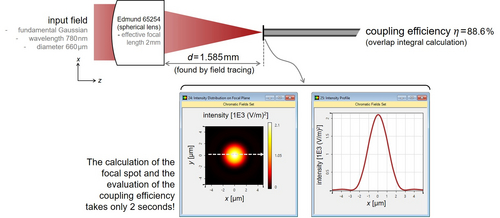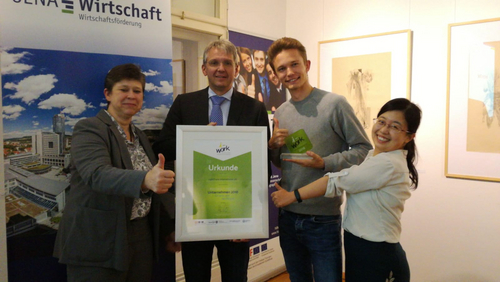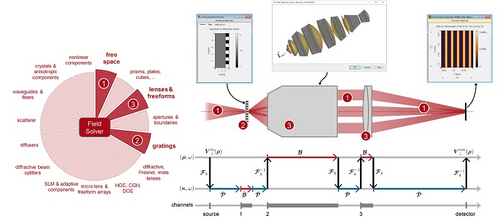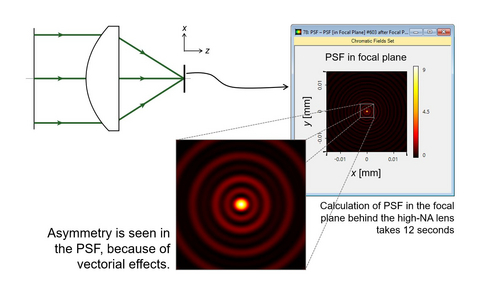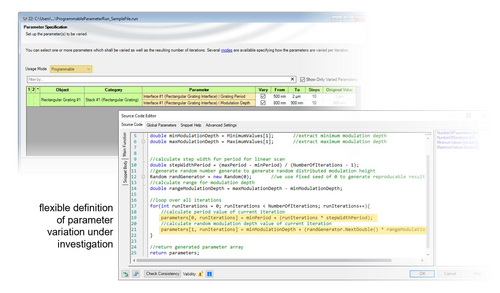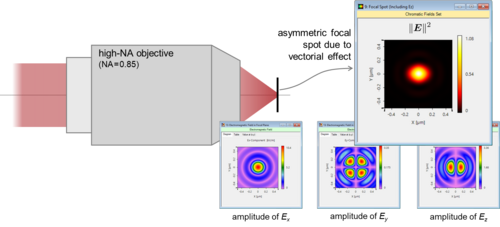What’s new in our Optical Modeling and Design Software?
Performance Evaluation of Fiber-Coupling Systems
Optical fibers are widely used in different applications; single-mode fibers especially play an important role in long-distance communications. Launching light into single-mode fibers can be a challenging task in practice. VirtualLab Fusion enables fast evaluation of fiber-coupling systems thanks to the physical-optics-based simulation techniques, fiber-related detectors, and many other helpful tools. For example, one can find the optimal working distance for coupling light into single-mode fibers, and compare the performance of different coupling lenses.
Read moreLightTrans awarded with the i-work-Business Award
Jena | 27 November
We are proud about winning the i-work Business Award.
Read moreBeyond Ray Tracing – Eindhoven & Garching
Eindhoven | Netherlands – 12 December
Garching | Germany – 15 January
Meet our experts and learn how to use VirtualLab Fusion
for the optical design tasks in your field of application.
Register for the seminars and indicate your areas of interest.
This information will be used to shape the content of the session.
Meet us at SPIE Photonics West
5 – 7 FEBRUARY 2019
SAN FRANCISCO, CALIFORNIA, USA
GERMAN PAVILION, BOOTH # 4545-46
* * *
This is a great chance for you to meet our technical experts and sales representatives for a discussion about the various application possibilities of the Fast Physical Optics Software VirtualLab Fusion.
In addition, we will give 3 talks and present 2 posters at the conference.
Read moreBeyond Ray Tracing - Delft, Netherlands/ Santa Clara, USA
Innovative Optical Design with Fast Physical Optics
FREE VirtualLab Fusion Seminar
Come to our free seminar to discover the fast physical optics concept, how to benefit from it through our user-friendly GUI, and to get an overview of what it can provide in a wide-ranging set of applications!
8 October 2018
Delft, Netherlands
Faculty of Applied Sciences, Building 22
-
22 October 2018
Santa Clara, CA, USA
ZGC Innocation Center
Vectorial Effects in High-NA Focusing Systems
In high-NA focusing systems, the vectorial nature of light starts to play a non-negligible role and it may affect the focal spot. Input polarization, the direction-dependent Fresnel coefficients at the surfaces and the diffraction effect that dominates the propagation of the field in the focal zone must all be considered in order to make reasonable predictions about high-NA setups.
In VirtualLab, all these effects can be included for the investigation of your system, and the focal fields can be calculated very efficiently.
Customizable Parameter Run and Parameter Coupling
To evaluate the actual performance of an optical system often requires the inclusion of complex real-world parameters like fabrication errors, misalignment, and even thermal/vibrational perturbances.
The Parameter Run in VirtualLab Fusion allows for the definition of such parameters in a completely customizable manner according to each specific case. Moreover, optical parameters may mutually influence each other, so that they do not change independently, but in a coupled way. VirtualLab also provides a customizable Parameter Coupling for the definition of any coupled parameters in the system.
Focal Region Investigation
Among the various types of optical components, lenses are probably the most widely used and focusing is possibly the most typical task. Although it might seem trivial, the behavior of light in focal regions can be complex and thus deserving of in-depth investigation. As an example, in the case of focusing with a high-NA objective lens, the focal spot is well known to show asymmetry, and consideration of the vectorial nature of light turns out to be necessary. In VirtualLab, the properties of light in focal region can be thoroughly investigated with the help of different kinds of detectors, and with the ParameterRun function the field evolution through the focal region can be analyzed as well.
Read more



